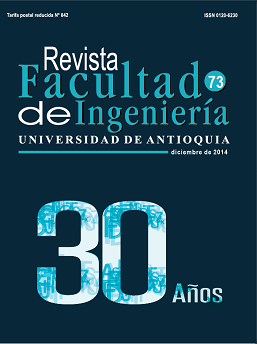Calculation of the helical parallel transmission of a wind turbine gearbox
DOI:
https://doi.org/10.17533/udea.redin.16530Keywords:
wind turbine, gearbox, helical parallel transmissionsAbstract
The gearbox of a wind turbine is the component of greatest mechanical complexity and is responsible for most wind turbines operational downtime and for increased costs. It doesn’t reach a 20 years projected life. All the studies, until now, indicate that these failures arise from the design process. This work demonstrates some of the inadequacies of the current design standards of wind turbines gearboxes, through the realization of a comparison of the results of the calculation of the helical parallel transmission of an 2,5 ME wind turbine, carried out by three ways: ISO 6336:2006 Method B and AGMA 2101-D04 (Metric Edition) standards and by using numeric simulation. The results of this analysis are that there are no problems of strength or rigidity in both transmissions, however the differences between these three calculation methods are considerable.
Downloads
References
H. Link, W. LaCava, J. van Dam, B. McNiff, S. Sheng, R. Wallen, et al. Gearbox Reliability Collaborative Project Report Findings from Phase 1 and Phase 2 Testing. Technical Report NREL/TP-5000-51885. National Renewable Energy Laboratory.Colorado, USA. 2011. pp. 1-88. Available on: http://www.nrel.gov/docs/fy11osti/51885.pdf Accessed: February 24, 2013. DOI: https://doi.org/10.2172/1018489
J. Helsen, F. Vanhollebeke, B. Marrant, D. Vandepitte, W. Desmet. “Multibody modelling of varying complexity for modal behaviour analysis of wind turbine gearboxes”. Renewable Energy. Vol. 36. 2011. pp. 3098-3113. DOI: https://doi.org/10.1016/j.renene.2011.03.023
W. Dong, Y. Xing, T Moan. “Time Domain Modeling and Analysis of Dynamic Gear Contact Force in a Wind Turbine Gearbox with Respect to Fatigue Assessment“. Energies. Vol. 5. 2012. pp. 4350-4371. DOI: https://doi.org/10.3390/en5114350
W. LaCava, J. Keller, B. McNiff. Gearbox Reliability Collaborative: Test and Model Investigation of Sun Orbit and Planet Load Share in a Wind Turbine Gearbox. Conference paper NREL/CP-5000-54618. National Renewable Energy Laboratory. Colorado, USA. 2012. pp. 1-13. Available on: http://www.nrel.gov/docs/fy12osti/54618.pdf Accessed: February 24, 2013.
J. Keller, Y. Guo, W. LaCava, H. Link, B. McNiff. Gearbox Reliability Collaborative Phase 1 and 2: Testing and Modeling Results. Conference paper NREL/CP-5000-55207. National Renewable Energy Laboratory. Colorado, USA. 2012. pp. 1-11. Available on: http://www.nrel.gov/docs/fy12osti/55207.pdf Accessed: February 24, 2013.
Y. Guo, J. Keller, R. Parker. Dynamic Analysis of Wind Turbine Planetary Gears Using an Extended Harmonic Balance Approach. Conference paper NREL/CP-5000-55355. National Renewable Energy Laboratory. Colorado, USA. 2012. pp. 1-18. Available on: http://www.nrel.gov/docs/fy12osti/55355.pdf Accessed: February 24, 2013.
International Organization for Standardization. Wind Turbines - Part 4: Standard for Design and Specification of Gearboxes. ISO/IEC 81400-4:2005. Geneva, Switzerland. 2005. pp. 7-27.
F. Oyague. Gearbox Modeling and Load Simulation of a Baseline 750-kW Wind Turbine Using State-of-theArt Simulation Codes. Technical Report NREL/TP500-41160. National Renewable Energy Laboratory. Colorado, USA. 2009. pp. 1-94. Available on: http://www.nrel.gov/docs/fy09osti/41160.pdf Accessed: April 14, 2013. DOI: https://doi.org/10.2172/947884
Oyague F. Gearbox Reliability Collaborative (GRC) Description and Loading. Technical Report NREL/TP5000-47773. National Renewable Energy Laboratory. Colorado, USA. 2011. pp. 1-28. Available on: http://www.nrel.gov/docs/fy12osti/47773.pdf Accessed: April 14, 2013.
F. Oyague. Progressive Dynamical Drive Train Modeling as Part of NREL Gearbox Reliability Collaborative. Conference paper NREL/CP-500-43473. National Renewable Energy Laboratory. Colorado, USA. 2008. pp. 1-16. Available on: http://www.nrel.gov/docs/fy08osti/43473.pdf Accessed: April 14, 2013.
F. Oyague, D. Gorman, S. Sheng. NREL Gearbox Reliability Collaborative Experimental Data Overview and Analysis. Conference paper NREL/CP-500-48232. National Renewable Energy Laboratory. Colorado, USA. 2010. pp. 1-14. Available on: http://www.nrel.gov/docs/fy10osti/48232.pdf Accessed: May 16, 2013.
J. Peeters. Simulation of dynamic drive train loads in a wind turbine. PhD Thesis. Department of Mechanical Engineering, Katholieke Universiteit Leuven. Leuven, Belgium. 2006. pp. 1-336. Available on: http://hdl.handle.net/1979/344 Accessed: May 16, 2013.
International Organization for Standardization. Calculation of load capacity of spur and helical gears. ISO 6336:2006 Method B. 2nd ed. 2006-09-01. Geneva, Switzerland. 2006. pp. 2-30.
AGMA. Geometry factors for Determining the Pitting Resistance and Bending Strength of Spur, Helical and Herringbone Gear Teeth. AGMA Standard 908- B89. Ed. American Gear Manufacturers Association. Virginia, USA. 1989. pp. 7-17.
KISSsoft. Design software for mechanical engineering applications. Copyright 1998-2011 by KISSsoft AG, Rosengartenstrasse 4, 8608. Bubikon, Suiza. Available on: http://www.KISSsoft.AG Accessed: May 16, 2013.
MatWeb. Database of material properties. AISI 1045 Steel, cold drawn. Blacksburg, USA. MatWeb, LLC. 2011. Available on: http://www.matweb.com/search/DataSheet.aspx?MatGUID=cbe4fd0a73cf4690853935f52d910784&ckck=1 Accessed: February 25, 2013.
J. Yang, L. Zhang. “Dynamic Response and Dynamic Load of wind turbine Planetary Gear Transmission System under changing excitation”. Applied Mechanics and Materials. Vol. 121-126. 2012. pp. 2671-2675. DOI: https://doi.org/10.4028/www.scientific.net/AMM.121-126.2671
Downloads
Published
How to Cite
Issue
Section
License
Copyright (c) 2018 Revista Facultad de Ingeniería

This work is licensed under a Creative Commons Attribution-NonCommercial-ShareAlike 4.0 International License.
Revista Facultad de Ingeniería, Universidad de Antioquia is licensed under the Creative Commons Attribution BY-NC-SA 4.0 license. https://creativecommons.org/licenses/by-nc-sa/4.0/deed.en
You are free to:
Share — copy and redistribute the material in any medium or format
Adapt — remix, transform, and build upon the material
Under the following terms:
Attribution — You must give appropriate credit, provide a link to the license, and indicate if changes were made. You may do so in any reasonable manner, but not in any way that suggests the licensor endorses you or your use.
NonCommercial — You may not use the material for commercial purposes.
ShareAlike — If you remix, transform, or build upon the material, you must distribute your contributions under the same license as the original.
The material published in the journal can be distributed, copied and exhibited by third parties if the respective credits are given to the journal. No commercial benefit can be obtained and derivative works must be under the same license terms as the original work.










 Twitter
Twitter